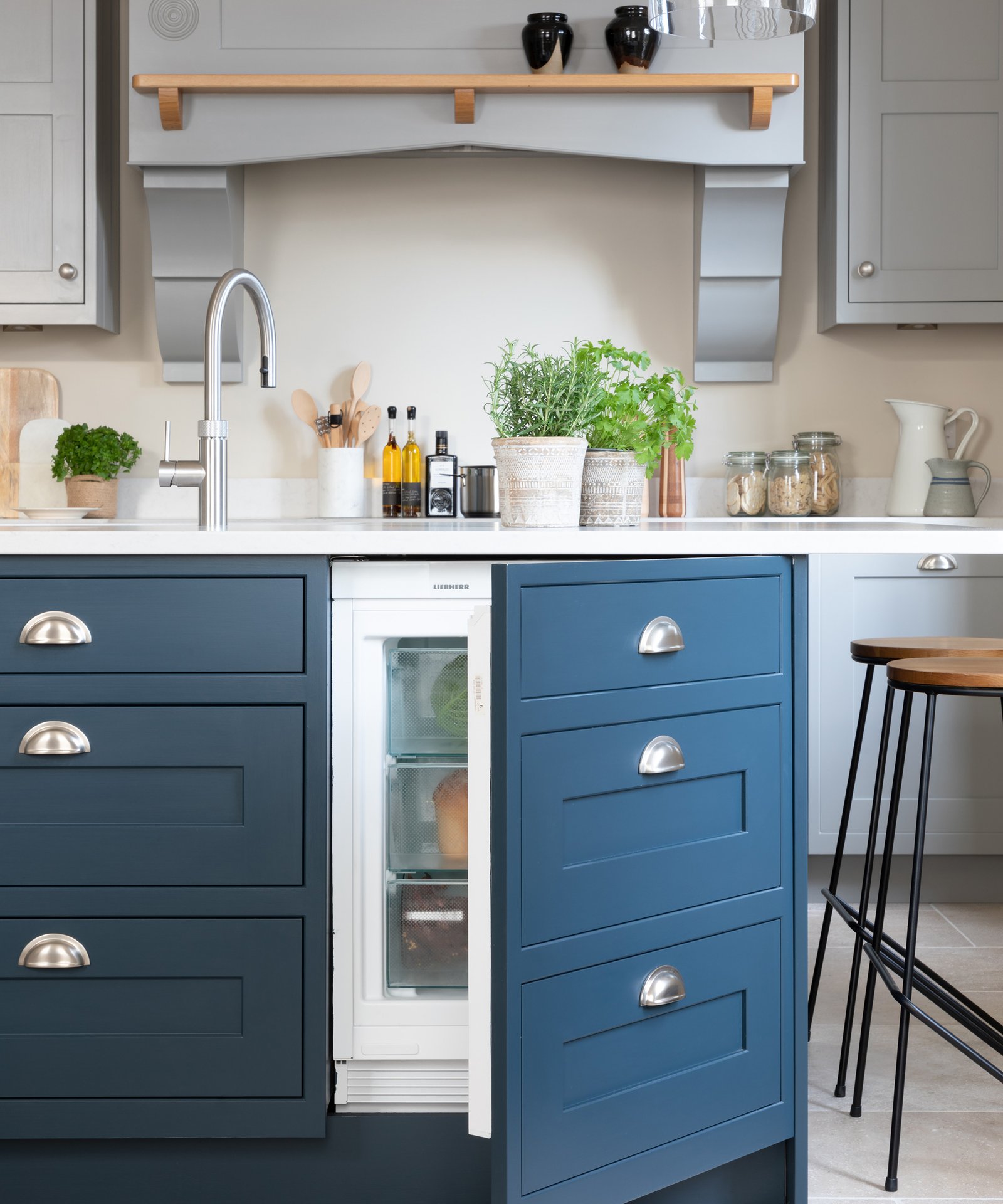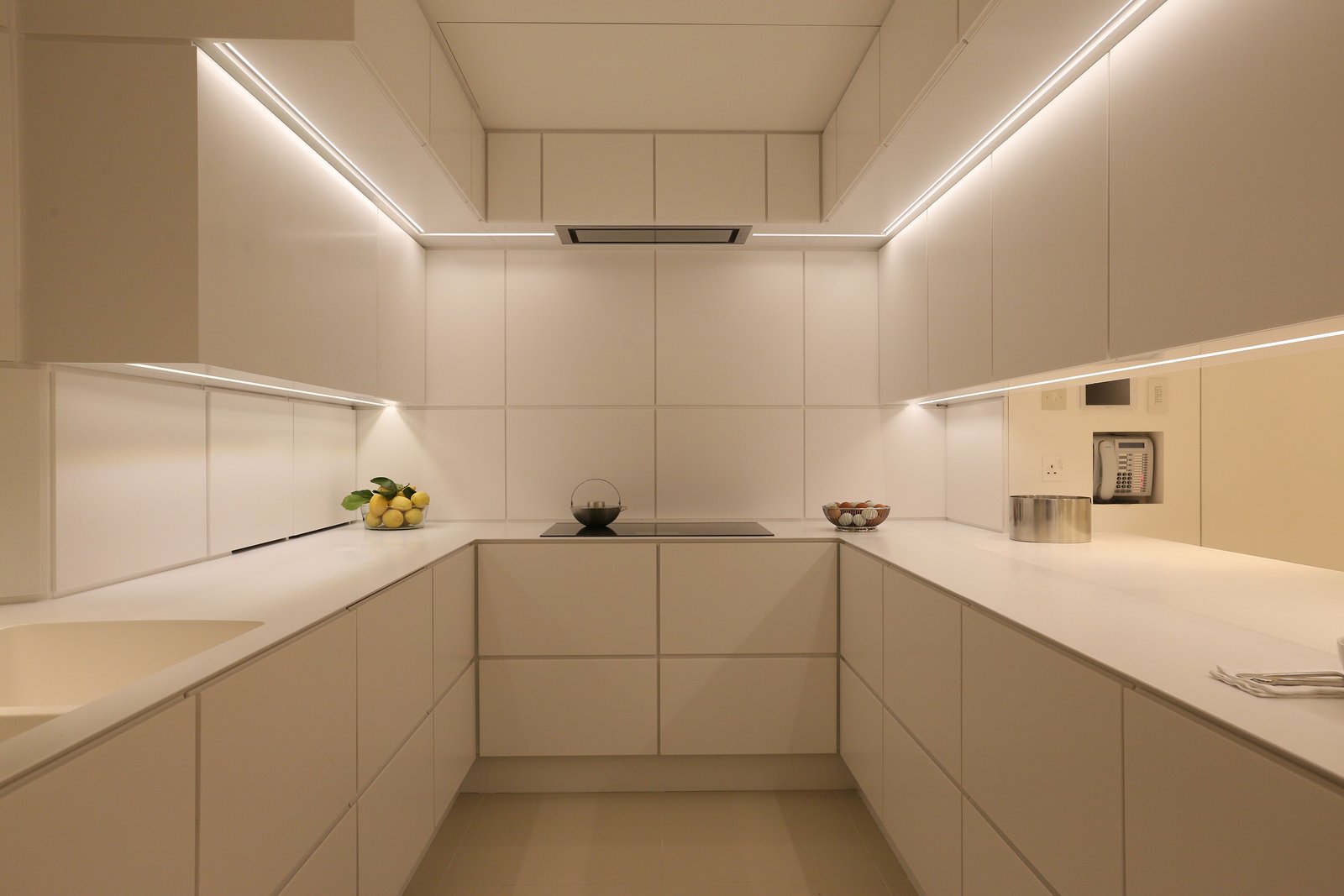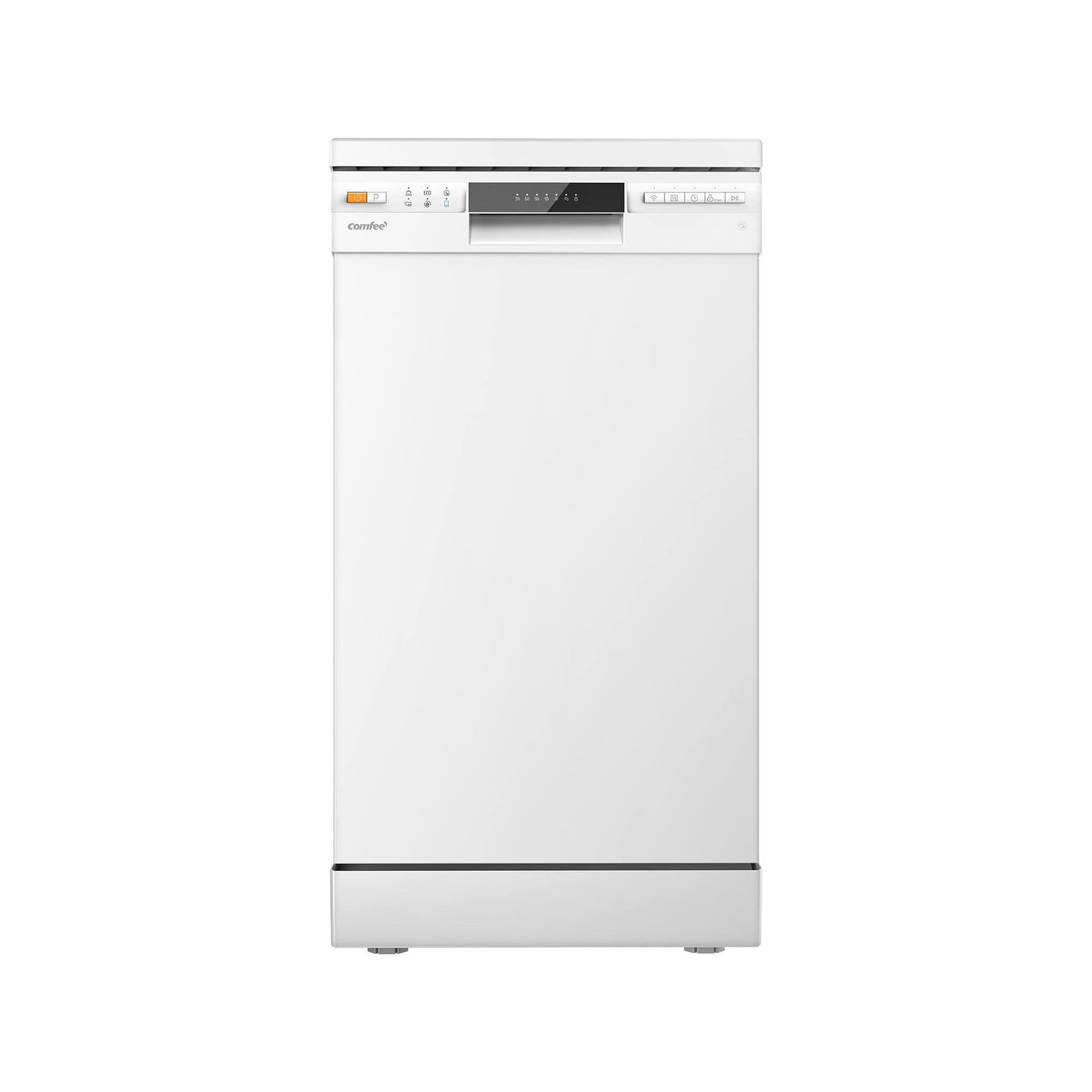Choosing kitchen appliances for your new space is often one of the best parts of designing a kitchen, really bringing the whole thing to life and transforming it into a practical space that will, in theory, make it possible to carry out all the tasks and activities you have planned.
That said, selecting the the best kitchen appliances for your needs is not always as straightforward as it might at first sound — there is far more to consider than whether they will do justice to the aesthetics of the space.
In this guide, we explain the main considerations you should be taking into account when choosing kitchen appliances that will meet all your needs. By arming yourself with this knowledge you can be sure that you will make the most of your budget and achieve the kitchen of your dreams.
Where to shop when choosing kitchen appliances
The very first decision you will need to make when choosing appliances is where you are going to buy them from.
There are two basic options here — to head out to a physical shop of some kind, or to buy online.
There is certainly much to be said for visiting a kitchen showroom, appliance specialist or department store in order to choose your appliances. You will be able to speak to the experts and garner their advice, as well as touch and see the products to test for quality and have a good close up examination.
On the downside, you might head out and spend a day trawling the shops for all types of cookers under the sun, only to return tired and empty handed. In addition, you might not always find the best deals by shopping in this way — particularly if you only have the energy to visit one shop.
Buying online might not allow you to see and touch the appliances in person, but you will usually be able to get a good idea of the products by reading customer reviews. Additionally, you will be able to scour the internet for the very best deals, all from the comfort of your own home.

Begin with a clear checklist
It can be really useful, before even starting to look for kitchen appliances, to arm yourself with a checklist of considerations. These considerations should form your final decision and they are what we will be covering in more detail in this guide. They include:
- Your budget: Think not only about the maximum you want to spend on your appliances but also what they will cost to run.
- Energy efficiency: In order to help with energy bills, you need to know what energy saving features are worth investing in.
- Your kitchen design: If you are looking for a modern finish, your choice of appliances will be different to those after a more classic look. You might also want to consider whether you want to include something like an appliance garage in your design
- Kitchen size: Those with more compact spaces to work with will need to be even smarter about their choices.
- How you use your kitchen: Your choice of appliances should reflect your individual household’s needs and the way you plan on using the space.
Setting a budget for your kitchen appliances
Perhaps the main overriding factor that will affect your choice of appliances will be your budget — the maximum you can (or are willing to) spend on this aspect of your kitchen ideas.
Of course it may be that you are only choosing one or two appliances, particularly if you are carrying out a kitchen renovation and already have some that are in perfectly good condition. If, on the other hand, you are starting from scratch, you will be looking at parting with a little more money. In this case, it is worth considering buying all your appliances from one source as many offer deals when purchasing multiple items — for example something like the Multibuy service from Appliance City.
“By taking advantage of our Multibuy service, you can get a personalised discount package,” explains Appliance City’s business development director James McCartney. “All you need to do is add all of your dream appliances to your Multibuy list, submit your request, and wait to hear back from us.”
It is also good to think about which items are worth spending a little more on and where cuts can be made.
“If budgets are limited, always go for the best appliances you can afford and buy from a reputable brand known for reliability and good after service,” advises Tom Hopper, kitchens category manager at Miele GB. “Look out for the most energy efficient option, as this will help you to save money in the long run. It is a significant investment and you will be living with your choices for a long time. Make sure you know what your options are and be open to new suggestions, such as considering a steam oven or induction hob if you were assuming you would have gas.”
It can help to have a rough idea of what the various appliances cost, on average:
- Built-in ovens: From approx. £150 for a single built-in oven with few features up to £1,900+ for smart ovens that combine steam cooking and self-cleaning functions.
- Hobs: If you are opting for a built-in oven, you will obviously need to choose a hob to use alongside it. Electric, solid plate hobs are the cheapest option, starting from as little as £50. Top-of-the-range induction hobs can cost £1,700 or more.
- Range cookers: Single oven ranges can be picked for as little as £400, while if you were to opt for an AGA or similar you could expect to pay up to £20,000 (or more…)
- Fridge freezers: This very much depends on whether you opt for a small fridge or a state-of-the art American-style fridge freezer. Lowest costs lie at around £99 for a basic under-counter model, up to £1,500 or more for tall, designer fridges — fridge freezers can cost more.
- Dishwashers: From £200, up to £1,600+ Integrated dishwashers can be more pricey
- Cooker hoods: From £50 up to £700+ This price will vary depending on the type of cooker hood

Tom is kitchens category manager at Miele GB and has a wealth of knowledge to share when it comes to both kitchen appliances and design.
Focus on energy efficient appliances
Just as important as how much your kitchen appliances cost to buy is how much they will cost you to run — and this is where taking note of their energy rating is key.
It is useful at this stage to note what proportion of your energy bills your individual kitchen appliances account for and get to grips with energy ratings for appliances.
Fridge freezers: “The running costs for fridge freezers account for 13% of the average UK household bill,” says James McCarthy of Appliance City. “These appliances need to be on 24 hours a day, and the average lifespan for them is 17 years, so, if you don’t currently have an energy-efficient model, it may be more cost-effective in the long run to invest in a new one.
“Energy labels for these range from A to G and you’ll see savings simply by moving up the energy efficiency scale. For example, by moving to a D energy label from an F, you’ll save around £570 over the 17-year lifespan of the appliance,” continues James.
Ovens: When it comes to ovens, convection (or fan assisted) are cheaper to run than conventional ovens as they cook food more efficiently. That said, if you are not much of a cook, it might be worth selecting a basic, low cost oven and sticking to a microwave for the majority of your cooking needs.
“According to USwitch, a price comparison website that helps users find the best deals on their household bills, the microwave is considered the most energy-efficient method of cooking food,” says James. “This is likely due to the small size of the appliance (which means there’s less space that needs to be heated) and the fact that it doesn’t require any preheating. It reaches its temperature instantaneously.”
Hobs: If you have decided on a built-in oven, you will need to buy a built-in hob — range and freestanding cookers feature both ovens and hobs in one unit. When it comes to ceramic vs induction hob, the most energy efficient hobs tend to be induction as these heat only the pan, rather than any section of unused surface. Gas hobs are also fairly energy efficient when compared to traditional ceramic or electric plate hobs as they heat up and cool down instantly.
Dishwashers: These are amongst the most energy-hungry appliances around, so it will really pay to opt for one with a higher energy efficiency rating here.
“According to Which?, an inefficient dishwasher (with a low energy rating) can cost over £2,000 in energy throughout the appliance’s lifetime,” states James McCarthy. “Opting for a model with an eco-setting can save you an additional 20% in energy use too.”
It isn’t just the energy rating of kitchen appliances that play a part in how efficient they are, however.
“Many of us are also looking to adapt to a more sustainable way of life in general, opting for ingredients which promote health and well-being. This has increased popularity of appliances that help us do so, like steam ovens and steam-combination ovens, which benefit from both steam and fan heat, save space and are great for those who love to cook and experiment with a wide range of dishes,” says Tom Hopper. “As well as looking at energy ratings, it’s important to look beyond the label and consider what else an appliance brand does to ensure sustainable production of its products.”


James is business development director at Appliance City. He is an appliance expert who has worked in the industry for over 30 years.
Choosing appliances to suit your kitchen design
When planning a kitchen it can be easy to become overly focussed on the way it looks and leave the practical considerations as something of an afterthought — but the two need to work together for the space to be a pleasure to spend time in.
Your choice of appliances will have a huge impact on the final look of your kitchen so bear this in mind when shopping around.
One of the main defining factors in the look of your installed appliances will be whether you opt for freestanding or integrated models.
“Consider whether you would benefit from a freestanding or integrated/built under model,” says Tom Hopper. “Freestanding appliances are a versatile option, with models featuring hard-wearing laminate tops offering the choice of being used as worktop space. Since the appliance is not built-in, it can be easily relocated if preferred or simply re-installed in a new kitchen if you move home.
“On the other hand, semi and fully integrated/built in appliances can be matched to the cabinetry of your kitchen or concealed behind matching furniture, for a seamless design.”
This is really a personal decision and there is little difference in terms of cost. Both built-in and freestanding appliances can suit either traditional or modern kitchens and give a nice sense of uniformity. Those seeking a more rustic look or or who have their hearts set on a freestanding kitchen might prefer the more eclectic look that freestanding appliances offer.

How do you use your kitchen?
The appliances you choose, how much you spend on them and the features they offer should really take into account the kind of cook you are, how you plan on using your kitchen (for example primarily for entertaining) and it’s layout. For example, if your design is all about great kitchen diner ideas, meaning a more open plan layout, quiet-running appliances should be a priority. If you mainly eat out, then a huge cooker will be a waste of money, as will a capacious dishwasher. Really factor in your lifestyle when it comes to appliances.
“Some people choose to spend more on premium appliances within a mid-range kitchen because they love to cook and want perfect results every time,” points out Tom Hopper. “Others would rather go for a stone worksurface and bespoke cabinetry and include only essential appliances.
“Then there are customers who only want the best of everything — for whom design, manufacture, longevity and sustainability credentials are as important as cooking and cleaning results. Plus they want the latest technology — ovens that are accurate to within one degree, dishwashers that can open with a simple knock, refrigeration that can keep food fresher for longer, built-in coffee machines that, with one touch, will create perfect barista style coffee in your own home. The key is to do your research — especially if this is your ‘forever’ kitchen.”

Which appliances will suit your kitchen size?
Certain appliances are going to suit differently-sized kitchens better than others. Obviously those searching for small kitchen ideas might need to look at ways of finding appliances that offer all the features they want in a compact package, but do bear in mind that if you have a huge kitchen, small appliances that look out of proportion in the space could also ruin the overall look of the room.
The good news for those with smaller spaces is that there are now a wide range of appliances designed specifically for compact kitchens.
“Having a small kitchen doesn’t mean it’s necessary to compromise on the latest technology and time-saving appliances,” reassures Tom Hopper. “Many of these appliances can now be integrated and built in to a kitchen design so they are completely hidden, helping to make the kitchen feel bigger and uncluttered.
For example, at Miele, we offer a slimline 45cm dishwasher with a QuickPowerWash option that can clean up to nine place settings in under an hour,” continues Tom. “Multifunctional ovens can also help to save space as this removes the need to have multiple cooking appliances, such as our new oven with air fryer capabilities which means there is no need to have a separate air fryer on the counter.”
“Choosing smaller and multifunctional appliances will reduce the amount of space they take up,” agrees James McCarthy. “With less space being used by appliances, you will open up the space, making your kitchen feel bigger. Compact appliances also often come with higher energy ratings.”
James goes on to suggest the following appliances as being perfect for those with small kitchens:
- Built in microwaves and banks of eye-level ovens
- Combination ovens
- Slimline dishwashers or ‘dishdrawers’
“For very small or galley kitchens, look for appliances with handleless doors — they will deliver a sleek, seamless and uninterrupted look helping to create the feeling of space,” suggests Tom Hopper.
“When it comes to extraction in smaller kitchens, concealed cooker hoods offer an unobtrusive yet powerful option that will remove kitchen vapours effectively,” continues Tom. “Concealed hoods can be installed underneath or in a wall unit, and certain models can also be fitted so that they are almost invisible if preferred. Slimline cooker hoods offer a discrete design in which a narrow, stainless steel trim beneath the wall unit is all that is visible, ideal to complement a seamless kitchen design.”

Our top three appliances for small kitchens

COMFEE’ Slimline Freestanding Dishwasher
The COMFEE’ Dishwasher holds an impressive nine place settings yet only measures 44.8cm wide. It can be controlled via the MSmartHome app — and is currently in Amazon’s Spring Sale!
Don’t forget the extra appliances
Alongside the more obvious ‘main’ kitchen appliances, there are also a wide range of other options that it can be really useful to include in your kitchen design — many of which look great combined with more modern kitchen design ideas. Do consider whether any of the following could also enhance your space:
- Built-in coffee machine
- Wine cooler
- Hot water tap
- Warming/proving drawers
As can be seen in this guide, choosing appliances is actually a very personal decision that needs to take into account your own lifestyle, routines, space requirements and budget.
It is also useful to think about your utility room ideas when it comes to appliances. For those with no separate utility, there will be additional appliances to fit into the kitchen space — namely the washing machine and tumble dryer, if you choose to have one.




